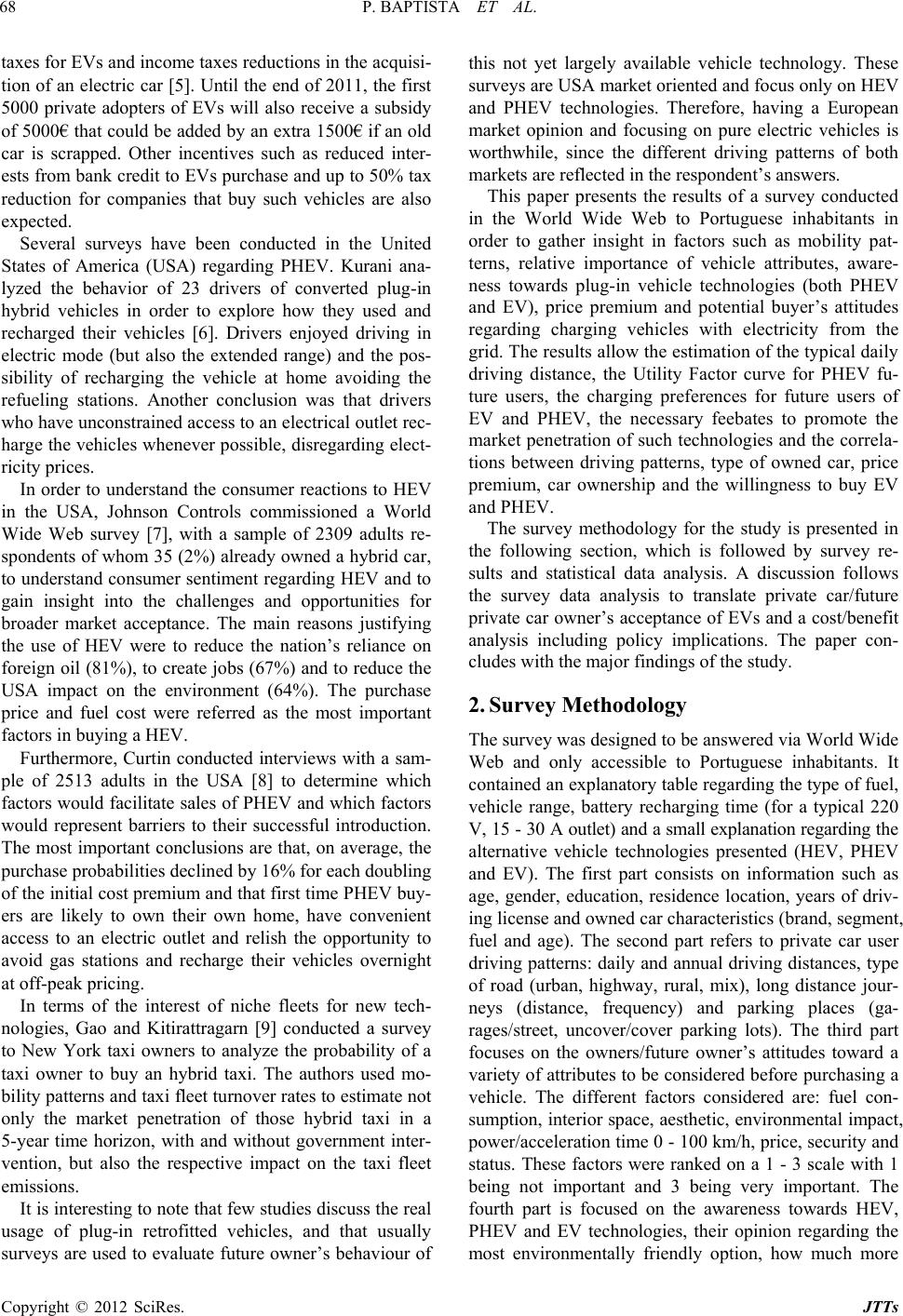
P. BAPTISTA ET AL.
68
taxes for EVs and income taxes reductions in the acquisi-
tion of an electric car [5]. Until the end of 2011, the first
5000 private adopters of EVs will also receive a subsidy
of 5000€ that could be added by an extra 1500€ if an old
car is scrapped. Other incentives such as reduced inter-
ests from bank credit to EVs purchase and up to 50% tax
reduction for companies that buy such vehicles are also
expected.
Several surveys have been conducted in the United
States of America (USA) regarding PHEV. Kurani ana-
lyzed the behavior of 23 drivers of converted plug-in
hybrid vehicles in order to explore how they used and
recharged their vehicles [6]. Drivers enjoyed driving in
electric mode (but also the extended range) and the pos-
sibility of recharging the vehicle at home avoiding the
refueling stations. Another conclusion was that drivers
who have unconstrained access to an electrical outlet rec-
harge the vehicles whenever possible, disregarding elect-
ricity prices.
In order to understand the consumer reactions to HEV
in the USA, Johnson Controls commissioned a World
Wide Web survey [7], with a sample of 2309 adults re-
spondents of whom 35 (2%) already owned a hybrid car,
to understand consumer sen timent regarding HEV an d to
gain insight into the challenges and opportunities for
broader market acceptance. The main reasons justifying
the use of HEV were to reduce the nation’s reliance on
foreign oil (81%), to create jobs (67%) and to reduce the
USA impact on the environment (64%). The purchase
price and fuel cost were referred as the most important
factors in buying a HEV.
Furthermore, Curtin conducted interviews with a sam-
ple of 2513 adults in the USA [8] to determine which
factors would facilitate sales of PHEV and which factors
would represent barriers to their successful introduction.
The most important conclusions are that, on average, the
purchase probabilities declined by 16% for each doubling
of the initial cost premium and that first time PHEV buy-
ers are likely to own their own home, have convenient
access to an electric outlet and relish the opportunity to
avoid gas stations and recharge their vehicles overnight
at off-peak pricing.
In terms of the interest of niche fleets for new tech-
nologies, Gao and Kitirattragarn [9] conducted a survey
to New York taxi owners to analyze the probability of a
taxi owner to buy an hybrid taxi. The authors used mo-
bility patterns and taxi fleet tu rnover rates to estimate not
only the market penetration of those hybrid taxi in a
5-year time horizon, with and without government inter-
vention, but also the respective impact on the taxi fleet
emissions.
It is interesting to note that few studies discuss the real
usage of plug-in retrofitted vehicles, and that usually
surveys are used to evaluate future owner’s behaviour of
this not yet largely available vehicle technology. These
surveys are USA market oriented and focus only on HEV
and PHEV technologies. Therefore, having a European
market opinion and focusing on pure electric vehicles is
worthwhile, since the different driving patterns of both
markets are reflected in the respondent’s answers.
This paper presents the results of a survey conducted
in the World Wide Web to Portuguese inhabitants in
order to gather insight in factors such as mobility pat-
terns, relative importance of vehicle attributes, aware-
ness towards plug-in vehicle technologies (both PHEV
and EV), price premium and potential buyer’s attitudes
regarding charging vehicles with electricity from the
grid. The results allow the estimation of the typical daily
driving distance, the Utility Factor curve for PHEV fu-
ture users, the charging preferences for future users of
EV and PHEV, the necessary feebates to promote the
market penetration of such technologies and the correla-
tions between driving patterns, type of owned car, price
premium, car ownership and the willingness to buy EV
and PHEV.
The survey methodology for the study is presented in
the following section, which is followed by survey re-
sults and statistical data analysis. A discussion follows
the survey data analysis to translate private car/future
private car owner’s acceptance of EVs and a cost/benefit
analysis including policy implications. The paper con-
cludes with th e major findings of the study.
2. Survey Methodology
The su rv ey w as d es ign ed to be ans w er ed v ia W o r ld Wi d e
Web and only accessible to Portuguese inhabitants. It
contained an explanatory table regarding the type of fuel,
vehicle range, battery recharging time (for a typical 220
V, 15 - 30 A outlet) and a small explanation regarding the
alternative vehicle technologies presented (HEV, PHEV
and EV). The first part consists on information such as
age, gender, education, residence location, years of driv-
ing license and owned car characteristics (brand, segment,
fuel and age). The second part refers to private car user
driving patterns: daily and annual driving distances, type
of road (urban, highway, rural, mix), long distance jour-
neys (distance, frequency) and parking places (ga-
rages/street, uncover/cover parking lots). The third part
focuses on the owners/future owner’s attitudes toward a
variety of attributes to be considered before purchasing a
vehicle. The different factors considered are: fuel con-
sumption, interior space, aesthetic, environmental impact,
power/acceleration time 0 - 100 km/h, price, security and
status. These factors were ranked on a 1 - 3 scale with 1
being not important and 3 being very important. The
fourth part is focused on the awareness towards HEV,
PHEV and EV technologies, their opinion regarding the
most environmentally friendly option, how much more
Copyright © 2012 SciRes. JTTs